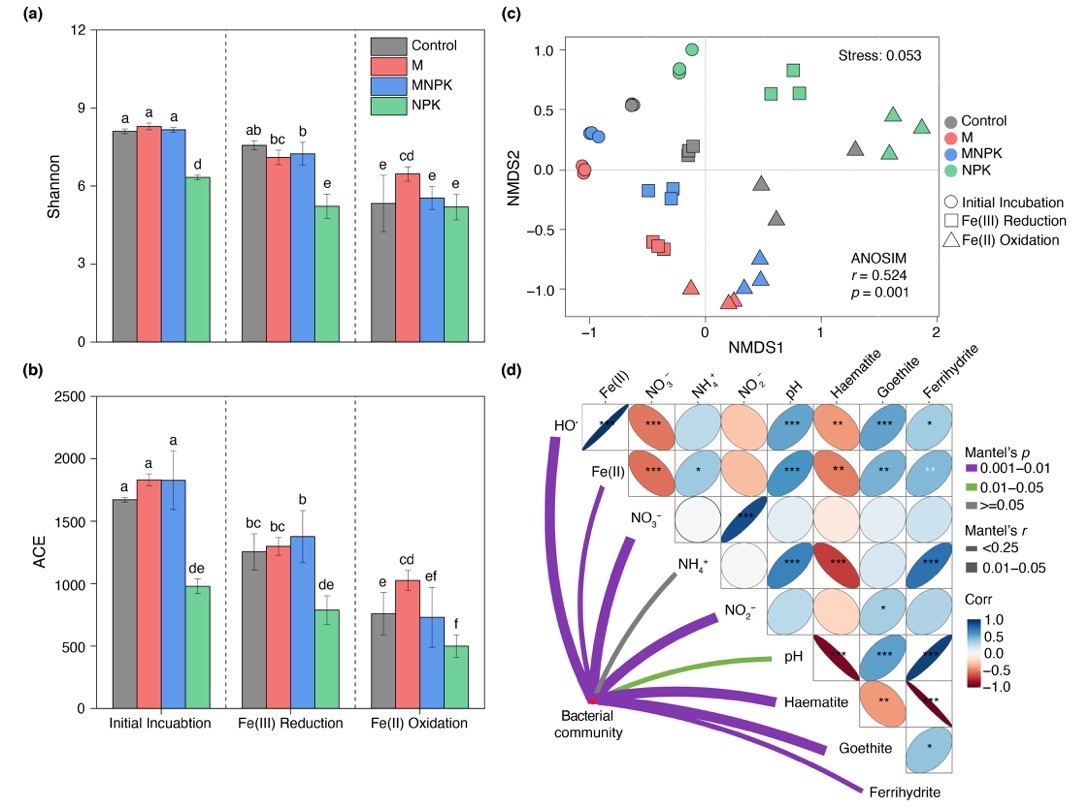The generation of reactive oxygen species (ROS) mediated by minerals and/or microorganisms plays a vital but underappreciated role in affecting carbon and nutrient cycles at soil-water interfaces.

Fig. 1. EXAFS shows the transformation of Fe minerals during microbially mediated Fe redox cycling
It is currently unknown which interactions between microbial communities and iron (Fe) minerals produce hydroxyl radical (HO•), which is the strongest oxidant among ROS. Using a series of well-controlled anoxic incubations of soil slurries, we demonstrated that interactions between microbial communities and Fe minerals synergistically drove HO• production (up to ~100 nM after 21-day incubation). Microorganisms drove HO• generation in anoxic environments predominantly by modulating iron redox transformation that was more prominent than direct production of ROS by microorganisms. Among the microbial communities, Geobacter, Paucimonas, Rhodocyclaceae_K82, and Desulfotomaculum were the key genera strongly affecting HO• production.

Fig. 2. Shifts in bacterial community diversity and the relationships between geochemical variables and bacterial communities
In manured soils, the former two species had higher abundances and were crucial for HO• production. In contrast, the latter two species were mainly abundant and important in soils with mineral fertilizers. Our study suggests that abundant highly reactive oxidant HO• can be generated in anoxic environments and the microbial community mediated redox transformations of iron (oxyhydr)oxides may be responsible for the HO• production. Altogether, our findings establish a causality between HO• production and microbial-mineral interactions at soil-water interfaces, and show the profound impact on carbon and nutrient cycles in anoxic environments.

Fig. 3. Potential microbial taxonomic predictors of Fe(II) and HO• production
These findings shed light on the microbial generation of HO• in fluctuating redox environments and on consequences for global C and nutrient cycling.

Fig. 4. SEM shows the relationships of potential microbial taxonomic predictors of HO• (derived from RF analysis) and iron (Fe(II) and the newly formed iron minerals) on HO• production.
These findings were published in journal of Water Research. The first author and corresponding author is Dan Wan and Prof. Guang-Hui Yu from Tianjin University, respectively. This study was financially supported by the National Natural Science Foundation of China (41977271 and 42003010) and China Postdoctoral Science Foundation (2019M661028 and 2021T140507). The authors thank the staff for their support at the BL14W beamline at Shanghai Synchrotron Radiation Facility (SSRF), for assistance during data collection.
Article information: Dan Wan, Fei-Fei Liu, Jiu-Bin Chen, Andreas Kappler, Yakov Kuzyakov, Cong-Qiang Liu. Guang-Hui Yu*. Microbial community mediates hydroxyl radical production in soil slurries by iron redox transformation. Water Research, 2022, 220: 118669.
Article Link: https://doi.org/10.1016/j.watres.2022.118689
By: School of Earth System Science
Editor: Qin Mian






